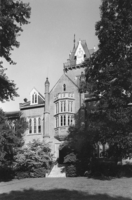 | Back to e-WV
| Back to e-WV
 The West Virginia Encyclopedia
The West Virginia Encyclopedia
 | Back to e-WV
| Back to e-WV
 The West Virginia Encyclopedia
The West Virginia Encyclopedia

Located in the village of Bethany, Brooke County, Bethany College came into existence through the granting of a charter by the Virginia General Assembly on March 2, 1840. From the beginning, it has been a four-year, baccalaureate-degree college, the oldest such institution in West Virginia. The college also granted earned and honorary master’s degrees from 1858 to 1931.
Founder Alexander Campbell (1788–1866) was a noted educational and religious reformer and one of the principal founders of the Christian Church denomination. Campbell served as president of the college until his death in 1866, as well as treasurer and one of the six original faculty members.
Bethany College has maintained a strong liberal arts curriculum throughout its history. The college is non-sectarian and governed by an independent board of trustees. However, strong historical ties with the Disciples movement provide a continuing relationship with the denomination.
The campus is dominated by Old Main, designated a National Historic Landmark, and one of the finest examples of 19th-century Gothic Revival architecture in the country. Begun in 1858, work on the building was interrupted by the Civil War and completed in the years immediately after. Two wings were subsequently added, Commencement Hall in 1871 and Oglebay Hall (now Kirkpatrick Hall) in 1912. Also designated a National Historic Landmark is the Campbell mansion, located a half-mile from the campus. The mansion began as a farmhouse (1793) on land owned by Campbell’s future father-in-law and was expanded in several stages throughout Campbell’s lifetime.
Campus life, originally dominated by literary societies, was leavened by the arrival of social fraternities in the 1850s. Delta Tau Delta national fraternity was founded at Bethany in 1858. Psi Chapter of Beta Theta Pi was established in 1860, making it the oldest fraternity chapter in continuous existence at the college and in the state.
The sectional strife leading up to the Civil War and the founding of the state of West Virginia provided a tremendous challenge to Bethany. As the campus drew its students from both slave and free states, Campbell attempted to dampen rancor by prohibiting political discussions, but was forced to dismiss several abolitionists as a matter of campus discipline after an incident in 1855. However, by the time of the outbreak of the war, campus sympathies were strongly pro-Union. Campbell opposed war, but his eldest son, Alexander Campbell Jr., rose to the rank of colonel in the armies of the Confederacy. Campbell’s nephew, Archibald Campbell, was the fiercely pro-Union editor of the Wheeling Intelligencer. Enrollment dropped to only 23 students in the 1862–63 academic year.
Women were first admitted as students on a provisional basis in 1877 and granted full status the following year. Women have served on the faculty since 1882 and on the board of trustees since 1900. International students were members of the first class in 1841 and make up approximately ten percent of the student body today. Minority students have been a part of the student body throughout the college’s history.
The Great Depression took its toll on the campus. Enrollment declined and money was hard to come by. During World War II, the college participated in programs for the army air corps and the navy to train pilots and engineers, in part to compensate for the loss of enrollment because of the war effort. Returning veterans aided by the GI Bill boosted enrollment in 1946 to more than 800, causing a serious housing shortage in the village. The 1960s brought a great surge in enrollment, and a corresponding expansion of facilities, as the ‘‘baby boom’’ generation began to enter college. Enrollment peaked at 1,100 in the early 1970s and then fell back to approximately 750 by the end of the 1980s. Enrollment in fall 2009 was 830.
Through the years, 21 individuals, including Campbell, have served as president of Bethany College. Among the most influential were T. E. Cramblet (1902–19), who presided over a major building boom in the first two decades of the 20th century; his son, W. H. Cramblet (1934–52), who shepherded the college through the Depression and the war years; Perry Epler Gresham (1953–72), who expanded the campus to meet the influx of the baby boomers; and Cecil H. Underwood (1972–75) the once and future governor of West Virginia. President D. Duane Cummins served from 1988 to 2002, Patricia L. Poteat from 2002 to 2004, G. T. Smith from 2004 to 2007, and Scott D. Miller became president in December 2007. Miller left in 2015, and Rev. Dr. Tamara Rodenberg was chosen to lead the college beginning January 1, 2016. Jamie Caridi has been the president since 2022.
Among Bethany’s benefactors over the years have been the Phillips family, originally from Pennsylvania, the Oglebay family of Wheeling, and the Renner family of Ohio. James A. Garfield, 20th president of the United States, was a member of the board of trustees. J. B. ‘‘Champ’’ Clark, Class of 1873, rose to the speakership of the U.S. House of Representatives. Other Bethany alumni have distinguished themselves in the arts, business, education, electronic and print journalism, industry, and science.
In fall 2021, the school’s enrollment was 559, increasing to 623 the following year.
Read the National Historic Landmark nomination for Old Main.
Written by Gary Kappel
Cummins, D. Duane. The Disciples Colleges: A History. St. Louis: CBP Press, 1987.
Gresham, Perry. Campbell and the Colleges. Nashville: Disciples of Christ Historical Society, 1973.
McAllister, Lester. Bethany: The First 150 Years. Bethany College Press, 1991.